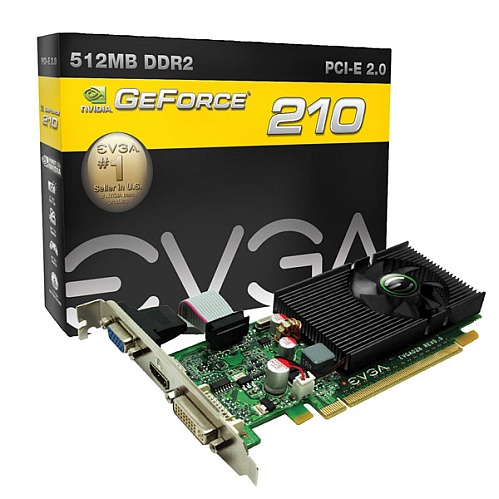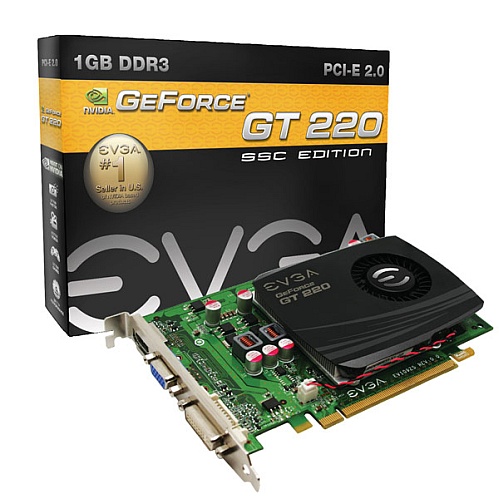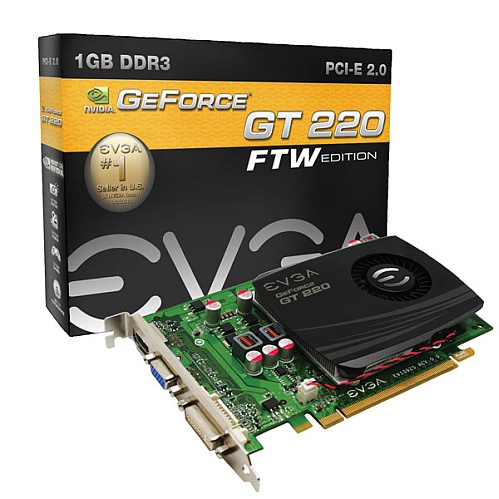Just recently, our friends over at EVGA added half a dozen cards to the company’s product lineup based on Nvidia’s mainstream budget 40nm GT218 and 40nm GT216 die packages, all supporting DirectX 10.1 and featuring native HDMI 1.3a input ports. In retrospect, Nvidia’s Geforce 210 and Geforce GT 220 cards might already be familiar to some due to their prior launches a few months ago as OEM-only parts (G210 and GT 220). This time around, EVGA and many other AIBs are receiving their chances to capitalize on this emerging budget-minded 40nm segment with a broad range of product possibilities for consumers to explore.
First on the list of these new 40nm cards is the EVGA Geforce 210 (512-P3-1210), commonly referred as the Geforce 9500 GT (55nm) replacement. This GPU has 16 processor cores, a 64-bit memory interface, runs at a 589MHz core clock, 1402MHz shaders, and has 512MB of DDR2 at 500MHz (respectively 1000MHz) and does not feature PhysX.

Like many similar cases of capitalism dominance in the past, EVGA has decided to go all out on its Geforce GT 220 lineup, offering five different flavors at marginal performance differences respectively. Logically, this particular model is to be the 40nm successor to the Geforce 9600GT (55nm). The EVGA Geforce GT 220 (512-P3-1220-LR) stock model features 48 processor cores, a 128-bit memory interface, runs at a 625MHz core clock, 1360MHz shaders, and has 512MB of DDR2 at 500MHz (respectively 1000MHz). According to a recent benchmark performed by PC Perspective, the GT 220 has roughly a 43 percent performance advantage in 3DMark Vantage over the Geforce 210 when both cards are ran at default clock speeds.

For those who demand higher marginal performance, EVGA has released two additional stocked-clocked versions of the Geforce GT 220 with 1GB of DDR2 (01G-P3-1225-LR) as well as 1GB of DDR3 (01G-P3-L226-LR) for additional memory bandwidth.
EVGA also understands the demand of the enthusiast crowd and has also released SuperSuperClocked and FTW Edition versions of the card. The EVGA Geforce GT 220 SSC Edition (01G-P3-1227-LR) features 48 processor cores, a 128-bit memory interface, runs at a 671MHz core clock, 1458Mhz shaders, and has 1GB of DDR3 at 790MHz (effectively 1580MHz).

Finally, the EVGA Geforce GT 220 FTW Edition (01G-P3-1228-LR) features 48 processor cores, a 128-bit memory interface, runs at an incredible 720MHz core clock, 1544MHz shaders, and has 1GB of DDR3 at 810MHz (effectively 1620MHz).

While Nvidia’s Geforce 210 and Geforce GT 220 serve as prime examples the next technological manufacturing process advancement at 40nm, it should be observed that these cards perform at or below the level of ATI’s HD 4600 series. Nevertheless, the GT 220 seems to be an ideally acceptable PhysX rendering solution offered at reasonable price points for a large range of budget-minded consumers, including those who simply want a low-power media playback desktop GPU. We are looking forward more to the release of the Geforce GT 240 next month as we can expect performance more comparable to the 9800GT (55nm) which would be ideal for tackling almost any PhysX rendering situation.
